Auto bailout ABCs
Here's how the bill passed by the House breaks down for the survival of the Big Three automakers.
 |
| A Congressional plan to save the U.S. auto industry has cleared one hurdle, but faces many more. |
NEW YORK (CNNMoney.com) -- With a bailout bill floating through Congress, America's automakers are hoping for a lifeline from Uncle Sam that could help them hold on until the summer.
The bill has made it through the House of Representatives, but it faces a tough fight in the Senate. It's not a complete answer to their problems, and it comes with some big strings attached, but it is the only viable plan on the table.
Here are the basics of the bill so far.
The House bill provides for $14 billion in government loans. The government would prioritize the loans based on need, ability to productively use the money and the potential economic impact of each automaker's failure.
Loan interest would be 5% for the first five years. After that, it would go up to 9%, and all the money would have to be paid back within 7 years. Carmakers wouldn't be penalized for paying back early.
If the carmakers aren't making sufficient progress in their restructuring plans, or aren't meeting set deadlines, the government could demand immediate repayment.
The President would select a designee to oversee the loans and the automakers' restructuring. Qualifications for the "car czar" job would include expertise in company turnarounds and environmental protection.
The czar would authorize the loans or lines of credit and assess each automaker's restructuring plan and its progress in meeting that plan.
By New Year's Day, 2009, the Czar would have to come up with a method for assessing each automaker's progress toward filing its own restructuring plan. 45 days later, he'd have to provide a report that measures each automaker's progress.
The czar would have the power to examine any records or interview any executive or employee to assess each automaker's progress toward creating and carrying out their plans.
Carmakers would have to report any significant activities to the czar during the term of the loan, such as a proposed asset sale, transaction or contract with a value greater than $100 million. That would include a sale of the companies.
The czar would have the power to prohibit any business move he thought would harm the company's long-term viability.
If the car czar felt he didn't have enough power to get the job done, he could request additional powers - or even new legislation - from Congress. The czar would report to the Comptroller General of the United States, who is in charge of the U.S. General Accountability Office.
An automaker's restructuring plan would have to lay out just how it would return to viability and repay the government's money.
Among other things, the automakers would need to show that they have a reasonable expectation of making money, that they can make more fuel-efficient cars, and that they're competitive in the U.S. market.
Since the plan could mean significant money sacrifices for anyone who does business with the automaker, the czar would facilitate meetings between the automakers and employee and retiree representatives, union representatives, suppliers, dealers and shareholders.
Detailed restructuring plans would have to be submitted to the czar by March 31. That deadline could be extended for 30 days if the czar believes the parties are negotiating in good faith and trying to reach a deal.
If the deadlines aren't met, the czar could demand that any money already doled out would be immediately returned and the carmaker could be shut off any further loans.
The chief executives of the Big Three have already agreed to work for a salary of $1 a year. While the bill doesn't stipulate specific salaries, it says that automakers would have to standards for compensation and governance.
Executives would get no bonuses, there would be no "golden parachutes" for departing executives, and the companies would not pay dividends to shareholders for the period of the loans.
There would also be limits on any compensation that encouraged senior manages to engage in risky business practices.
For manufacturers with publicly traded stocks, the government would get warrants enabling it to buy non-voting shares worth 20 percent of the amount of the loan.
For Chrysler, which is privately owned by Cerberus Capital Management, the government would receive warrants to buy equity in either Chrysler or in Cerberus itself.
After the fracas that erupted when the Big Three CEOs rode in private planes to their first hearing on Capitol Hill in November, corporate jets would be out - at least as long as government loans were outstanding. Automakers would not be allowed to own, lease or even share in any private aircraft.
Automakers would also be required to seriously study the possibility of using idle factories to produce vehicles for sale to mass transit agencies. They'd have to look at the potential market for buses and trains and their parts and submit a report to the GAO, which would provide reports to Congress and czar.
In its current form, it's far from certain this bill will be passed by the Senate. Some Republicans say it's simply not strong enough to ensure success.
Sen. Bob Corker, R-Tenn., threw out three legislative changes he said would allow the automakers to make the changes they need to be competitive.
He proposed that GM and Chrysler must reduce their debt by two-thirds by March 15 or file for bankruptcy.
He also said the UAW would have to accept significant equity in the companies to help offset future retiree health care payments, instead of cash or other assets the companies were to contribute to union-controlled trust funds
Finally, he said the union would have to accept pay cuts for GM and Chrysler workers to levels paid at the U.S. plants of overseas automakers. ![]()


